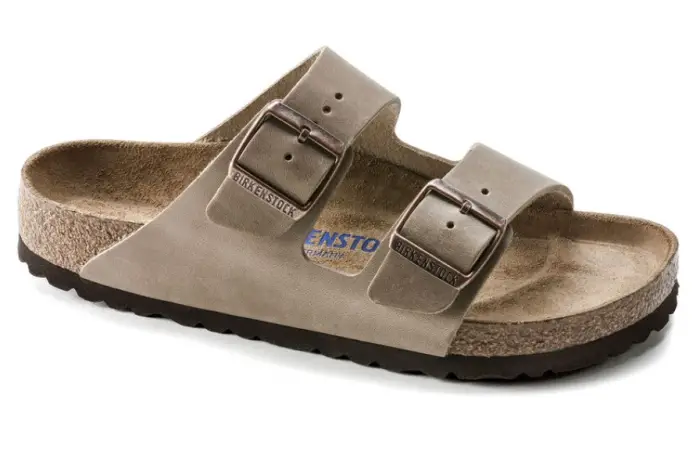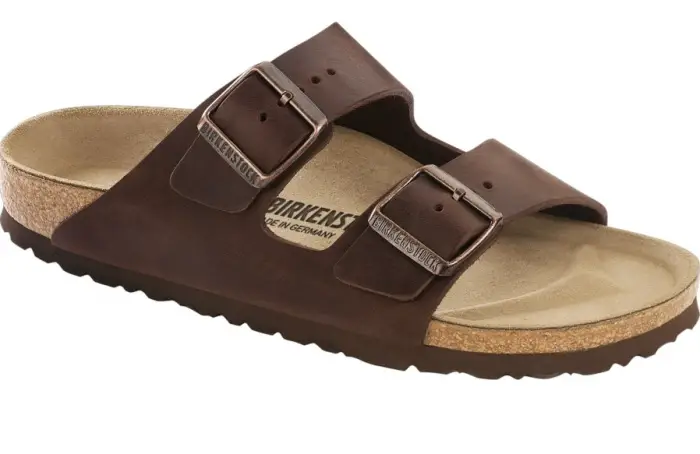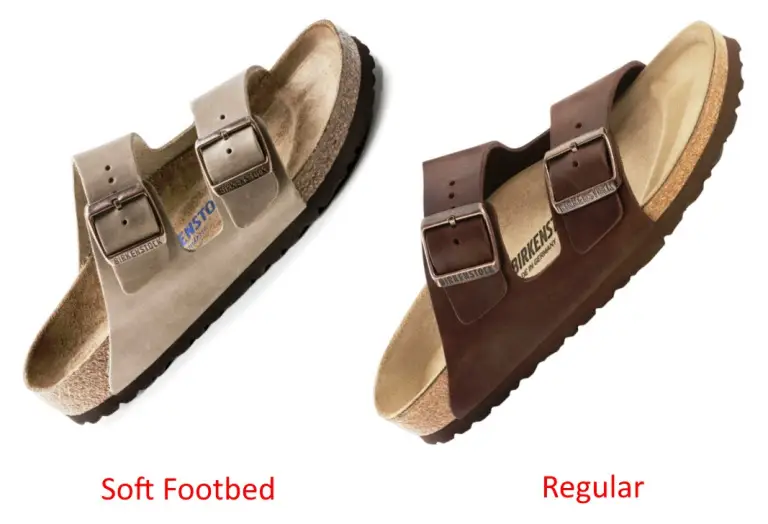Blog
Birkenstock Soft Footbed vs Regular: In-depth Comparison
When it comes down to Birkenstock soft footbed vs regular, which is your best bet? What’s the difference between them if the designs are almost identical? And, last but not least, do they have any disadvantages?
This in-depth comparison will explore the similarities and crucial differences between these two iconic options, guiding you to select the best Birkenstock comfort for your unique needs. Whether you’re seeking daily wear, specific arch support, or simply the classic Birkenstock experience, understanding each footbed’s characteristics is key.
Contents
- Birkenstock Soft Footbed vs Regular: Similarities
- Differences Between Soft Footbed vs Regular Birkenstock
- Pros & Cons Of Soft Footbed Birkenstock
- Pros & Con Of Regular Footbed Birkenstock
- More FAQs about Birkenstock Soft Footbed vs Regular Footbed
- Birkenstock Soft Footbed vs Regular Footbed: Which Is Better?
Birkenstock Soft Footbed vs Regular: Similarities
Birkenstock is a popular brand, hence they have certain game-changer factors that make their products more recognized than others, and Birkenstock Footbed is one of them. Living up to the name, the footbed is insoles made to embrace and support your feet.
Within the seemingly simple shape lies a variety of details thoroughly calculated to fit perfectly and ensure nothing less than comfort. The complex structure might catch you by surprise, yet your body weight won’t be distributed properly without it.
Features of Birkenstock Soft Footbed & Regular
- Heel cup: As most problems with our feet come from the heels and directly affect the legs and the spine in a straight line, the heel cup is extremely important to maintain the natural state of the bones and support every step you take.
- Longitudinal Arch Support (Lateral & Medial): Both the inside (medial) and outside (lateral) arches are meticulously supported. This aids in preventing foot fatigue, reducing strain on joints, and ensuring proper posture throughout the day. It’s particularly beneficial for those with various arch types, offering comprehensive support.
- Transverse arch support: Located at the ball of the foot, this raised section helps distribute pressure evenly across the forefoot, preventing discomfort and promoting a balanced gait.
- Raised Toe Bar (Toe Grip): Designed to encourage the natural gripping motion of the toes, this feature stimulates circulation and provides additional stability, engaging the muscles of the foot.
- Footbed edge: Belonging to the outer compositions but not inferior in terms of importance, the edge of the footbed shields the whole of your foot from possible damage from outside.
Materials of Soft Footbed & Regular Birkenstock
Birkenstock uses 4 materials for their legendary footbed, all of which have natural origins: cork, latex, jute, and suede.
- Cork: As the cushion, cork is an extremely suitable material. It has numerous pores to circulate air, which makes the footbed light and breathable. Heat and coldness will be insulated and absorbed sufficiently so your feet won’t ever feel uncomfortable.
- Latex: The granules of the cork will remain separate if not adhered to by latex.
- Jute: With two layers of jute, one as the foundation and one as the sides of the footbed. Jute is very durable and adsorbent, hence moisture and mold will be the last problem you need to worry about.
- Suede: As the lining, suede is the major factor in guaranteeing a pleasant climate for your feet. The fine fabric is utterly soft against your skin as well.
These shared attributes ensure that regardless of your choice, you are investing in a product built for durability, value, and anatomical well-being.
Benefits of Birkenstock Footbed

There are reasons why many buyers rely on Birkenstock:
- Durability: The brand has been around since 1774, being at the peak of quality means they are very good at what they do. They want customers to get the most out of their shoes and come back for more, hence they use nothing less than fine materials and smart designs.
- Value: We can all agree that whether it is soft vs regular Birkenstock or any other product line, the price is always slightly costly. But the value offered for that price is usually money spent well.
- Services: If you encounter any problem with your purchase, you can have it repaired instantly.
The regular footbed is the standard for all Birkenstock shoes to follow, thus the soft footbed has the same structure and material discussed above. However, additional details don’t necessarily mean it is better and perfect.
Differences Between Soft Footbed vs Regular Birkenstock
The primary differentiator between the soft footbed and the regular footbed lies in an additional layer of cushioning and the immediate user experience.
The Birkenstock soft footbed incorporates an integrated layer of foam cushioning, often referred to as a “cushioning foam insert,” directly beneath the suede lining. This extra foam provides an instant feeling of softness and comfort from the moment you slip them on. For many, this translates to a “broken-in” feel right out of the box, eliminating the traditional adjustment period often associated with new Birkenstocks.
This immediate plushness makes the soft footbed a popular choice for individuals seeking quick relief or those with more sensitive feet who prefer a less rigid initial feel. It’s also often recommended for people with very low arches or those who spend significant time on hard surfaces.
In contrast, the Birkenstock regular footbed does not feature this additional foam layer. It relies solely on the natural give and contouring of the cork and latex blend, along with the suede lining. While initially firmer, the regular footbed is renowned for its unique ability to gradually mold and conform precisely to the unique contours of the wearer’s foot over time.
This “breaking-in” process, which can take anywhere from a few days to a couple of weeks depending on wear, results in a custom-like fit that many users find unparalleled in long-term support and comfort. This option is highly versatile and suitable for a wide range of foot types, including those with average to higher arches, and for individuals who value a truly personalized fit that evolves with their usage.
Check more: Birkibuc vs Birko Flor Birkenstock: Which To Choose?
Pros & Cons Of Soft Footbed Birkenstock
The most obvious downside of the Birkenstock footbed is it needs time for the cork layer to embrace the shape of your feet, and the soft footbed was created for the sole purpose of making up for the needed break-in time. You will get the comfort you want as soon as the shoes are out of the box and secured around your feet.
While the foam provides softness, it is not the same feeling you get from trainer shoes. Knowing foam texture, you would expect it to be sturdy enough to support your steps and grant health benefits. And this is why Birkenstock has a good reputation.
However, the disadvantage of the foam is its memory ability. When you take your shoes off, the imprint of your feet will fade off and the foam will return to its original state. Therefore, the first impression you have is extremely important, for you will have to stick to it for a long time.
Check The Soft Footbed Birkenstock on Amazon.com
Who should use the Soft Footbed?
People whose feet have a low arch will benefit the most from it. They can feel the arch support more clearly, and the footbed will adjust to them more quickly. With that said, a soft footbed is good for plantar fasciitis or sensitive feet in general.
Pros:
- It feels soft and sturdy at the same time right after it is out of the box.
- Sensitive feet need the kind of support it provides.
Cons:
- It doesn’t feel better as time goes on because of the memory foam.
Pros & Con Of Regular Footbed Birkenstock

Check The Regular Footbed Birkenstock on Amazon.com
Like most classic and high-end shoes, Birkenstock’s regular footbed needs time to mold to the shape of your feet and soften itself, or “break in”. Nonetheless, the wait might be worth it, because once they have overcome the tough phase, they are significantly more comfortable.
The original footbed can almost change your posture and your foot shape. As we previously mentioned, the footbed keeps your toes and your heels in a comfortable position.
Maybe you will find the sensation unfamiliar at first since common shoes can only do one thing – they either give you comfort or give your feet relaxation. Meanwhile, Birkenstock aspires to do both.
Who should use the Regular Footbed?
The regular footbed can handle both low and high arches, for they will eventually accommodate your feet.
Pros:
- It is a perfect fit for flat feet as well as arched feet once you pass the adjustment era.
- Great arch support.
- The most comfortable in the long run.
Cons:
- It requires a few weeks to break in.
More FAQs about Birkenstock Soft Footbed vs Regular Footbed
1. How do I care for my Birkenstock soft footbed versus the regular footbed?
While both Birkenstock footbeds are built for durability, their care can differ slightly due to the materials.
For the regular footbed, routine cleaning involves gently brushing off dirt and wiping the cork with a damp cloth, allowing it to air dry away from direct heat. The soft footbed, with its additional foam layer, requires similar care for the suede and cork, but it’s particularly important to avoid oversaturating the footbed when cleaning, as excessive moisture can affect the foam’s integrity.
Always ensure both footbeds are completely dry before wearing them again to prevent odor and material degradation. It’s also advisable to use cork sealant on the cork sole regularly to protect it from drying out and cracking, especially if you live in a dry climate.
2. Can the soft footbed still mold to my foot over time, or is that unique to the regular footbed?
The classic “molding to your foot” experience is more pronounced and inherent to the Birkenstock regular footbed, as its denser cork-latex core gradually conforms to your unique foot shape through consistent wear.
While the soft footbed offers immediate cushioning due to its integrated foam layer, it will still adapt to your foot’s contours over time, though perhaps to a lesser degree than the regular footbed.
The foam provides an initial personalized impression, but the underlying cork will also respond to your weight and pressure, creating a comfortable, supportive fit that feels custom-made, just with an added layer of initial softness.
3. Are Birkenstock soft footbed shoes more suitable for specific activities or environments?
The Birkenstock soft footbed excels in environments where immediate comfort and cushioning are paramount. This makes them particularly suitable for individuals who spend extended periods standing or walking on hard, unforgiving surfaces, such as retail workers, healthcare professionals, or anyone on concrete floors.
They are also an excellent choice for those with sensitive feet or conditions like plantar fasciitis, where extra shock absorption can alleviate discomfort. While versatile for everyday casual wear, their softer feel might be less ideal for activities requiring maximum ground feedback or extremely vigorous movement compared to the firmer, more responsive regular footbed.
Birkenstock Soft Footbed vs Regular Footbed: Which Is Better?
The winner between Birkenstock soft footbed vs regular footbed is up to you in the end. The soft footbed offers instant gratification, while the regular footbed delivers a personalized fit through gradual adaptation. By considering your individual needs and comfort preferences, you can confidently select the Birkenstock footbed that will bring you lasting walking pleasure.


I have fallen arches, which are causing issues with my knees, hips, and back. Since 1995, I have been wearing Birkenstock sandals, which provide better support for my feet than some orthopedic brands I have tried. Now, I am looking for a pair of tennis shoes, and I noticed that Birkenstock has a style called Bend. I want to check if the Bend is available in local stores. I believe it’s better to try the shoes in person rather than order them online and potentially have to return them due to an improper fit. Birkenstock offers a variety of styles to suit everyone. I found the differences between the Birkenstock regular footbed and the soft footbed to be very helpful.
thanks so much